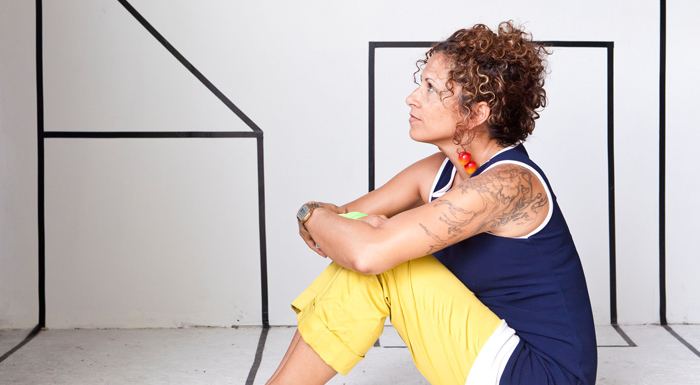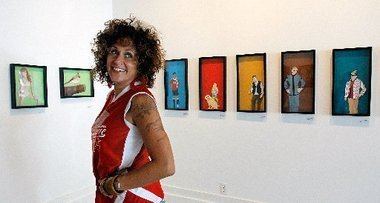Name Jackie Sumell | ||
 | ||
Born July 11, 1973 (age 52) ( 1973-07-11 ) Brooklyn, New York, U.S. Occupation Artist, author, activist | ||
In context 3 jackie sumell
Jackie Sumell (born 1973) is an American multidisciplinary artist and activist whose work interrogates the abuses of the American criminal justice system. She is best known for her collaborative project with Angola 3 member Herman Wallace entitled 'The House That Herman Built'. The House That Herman Built is the subject of critically acclaimed documentary film aired PBS entitled 'Herman's House'. Sumell is a 2007 Akademie Schloss Solitude Fellow, a 2013 Open Society Soros Justice Fellow, a 2015 Nathan Cummings Foundation Recipient, a 2015 Eyebeam Project Fellow and a 2016 Robert Rauchenberg Artist as Activist Fellow.
Contents
- In context 3 jackie sumell
- Don t buy a dishwasher jackie sumell tedxtu
- Early life
- Education
- Early Work
- The House That Herman Built
- Solitary Gardens
- References

Don t buy a dishwasher jackie sumell tedxtu
Early life

Sumell was born in Brooklyn and grew up in Long Island, New York. Sumell was the first girl to play competitive tackle football in an all boys league in the New York. She graduated from Connetquot High School and went on to play Division I soccer at the College of Charleston.
Education

Sumell received a Bachelor of Science from the College of Charleston in 1996. She received a Post-Baccalaureate degree from San Francisco Art Institute (2001), and a Master of Fine Arts in New Practices from Stanford University in 2004.
Early Work

While working on her M.F.A. at Stanford, Sumell challenged President George Bush's election and his policies towards women through a project entitled "No Bush". Sumell asked women to shave their pubic hair and send it to her in a plastic bag, which she then exhibited on a clothesline at the National Mall to draw attention to the erosion of pro-choice laws under the Bush administration. While in residency at the Temple Bar Gallery in Dublin Ireland, Sumell's exploration of locality, difference and identity called A=AGHT connected youth from New Orleans to youth from Dublin through the creation of an imaginary city.
The House That Herman Built
In 2001 Sumell attended a lecture in San Francisco where she met freed Angola 3 member Robert King. Sumell was moved by King's composure despite his having spent 29 years in solitary confinement and asked him how she could become more involved with the Angola 3 movement. King replied that she should begin by writing his comrades, Albert Woodfox and Herman Wallace. Wallace had been imprisoned since 1972 when he was placed in solitary confinement after being accused of the murder of a prison guard at the Louisiana State Penitentiary at Angola. After 2 years of correspondence with Wallace, while Sumell was still at Stanford, she asked Wallace a question that was meant to be posed to a professor as the basis for an assignment. The project was to ask a client to describe their dream home. Wallace's answer to this question would serve as the basis for the ongoing collaborative project The House That Herman Built and a follow-up documentary film: Herman's House. The 11 year collaboration between Sumell and Wallace tours as an art exhibition used to engage the viewing audience in a dialogue about the use of long-term solitary confinement in America's prisons. Using imaginative space to build the house that Herman Wallace envisions, Sumell connects the human imagination to the realities of the prison system. In addition to mounting the exhibit, Sumell is endeavoring to build The House That Herman Built as full size structure in Wallace's hometown of New Orleans. The house, at Wallace's behest, will be used as a community space committed to youth outreach and education. As it was originally conceived, The House That Herman Built is designed to be an open space that encourages the exchange of ideas, art and activism and will be open for anyone to visit and learn about the practice of solitary confinement. The exhibition that renders to scale the model of Herman's house has been shown in more than a dozen countries. Some of these exhibitions include The American Visionary Art Museum in Baltimore, The Brooklyn Library Main Branch The Royal College of Art in London, Artist's Space in New York City, The Akademie Schloss-Solitude in Stuttgart Germany, The St Etienne Biennial, France, The Alternator Gallery in British Columbia, Vancouver, Prospect 1 in New Orleans, & ZKM Karlsruhe Germany.
In the wake of Herman Wallace's death (October 4, 2013), Sumell continues to be active in the movement to end the use of long-term solitary confinement in the United States and is an advocate and spokesperson for the Angola 3 speaking frequently on their behalf at rallies, benefits and lectures. Ms Sumell's life and work is documented in the photojournalistic essay here
Solitary Gardens
Since Herman's passing in 2013 Ms Sumell embarked on another major project entitled the Solitary Gardens. The Solitary Gardens is a public art project and land use alternative by jackie sumell that begs us to imagine a landscape without prisons. The project utilizes the tools of prison abolition, permaculture, and alternative education to facilitate unexpected exchanges between persons subjected to solitary confinement and volunteer communities on the “outside.” The six-foot-by-nine-foot Solitary Gardens maintain the blueprint of a US solitary cell and are “gardened” by prisoners through written exchanges with volunteers. Prisons are the descendants of slavery. Solitary Gardens will be constructed from the ancestral byproducts: sugarcane, cotton and indigo—exposing the illusion that slavery was abolished. Solitary Gardens are generously supported by the Nathan Cummings Foundation, Eyebeam NYC, New Orleans Redevelopment Agency (NORA) and the Robert Rauschenberg Foundation. Ms Sumell still intends to build Herman's House in New Orleans, where Herman enjoyed most of his days of freedom.
